Blue Lasers
Definition: lasers emitting blue light
More general term: visible lasers
German: blaue Laser
How to cite the article; suggest additional literature
Author: Dr. Rüdiger Paschotta
This article deals with lasers emitting in the blue and violet spectral region, i.e., with a wavelength roughly around 400–500 nm. The choice of laser gain media for such wavelengths is limited, and the achievable performance is typically not as good as in, e.g., the infrared spectral region.
Types of Blue Lasers
The following types of blue lasers are the most common:
- Blue laser diodes [4], typically based on gallium nitride (GaN) or related materials (e.g. InGaN) and emitting around 400–480 nm, are relatively difficult to produce for high output power and long lifetime. Output powers of tens to hundreds of milliwatts are possible. Currently only a few types of devices are commercially available; the pioneering company is Nichia, followed by Sony and Sharp. The progress in this area is rapid, and it is to be expected that blue laser diodes will continue to exhibit improving performance and lifetime figures and will be widely used. A new development is that of blue-emitting VCSELs [11].
- Thulium-doped or praseodymium-doped upconversion lasers based on fibers or bulk crystals can emit around 480 nm, typically with some tens of milliwatts of output power and with good beam quality. Further development for powers of hundreds of milliwatts or even multiple watts appears to be feasible.
- Helium–cadmium lasers (which are gas lasers) can emit hundreds of milliwatts in the blue region at 441.6 nm, with high beam quality.
- Blue or violet light can also be generated by frequency doubling (external to the laser resonator or intracavity) the output of lasers emitting around 800–1000 nm. Most frequently used are neodymium-doped lasers, e.g. Nd:YAG emitting at 946 nm (for 473 nm), Nd:YVO4 at 914 nm (for 457 nm), and Nd:YAlO3 at 930 nm (for 465 nm). Common nonlinear crystal materials for frequency doubling with such lasers are LBO, BiB3O6 (BIBO), KNbO3, as well as periodically poled KTP and LiTaO3. Output powers of multiple watts can be obtained, even with single-frequency operation and high beam quality, although less easily than with 1-μm lasers. Instead of a laser, an optical parametric oscillator may be used.
- High-power optically pumped VECSELs are also very attractive laser sources for frequency doubling with several watts or even tens of watts of output power. Note that other kinds of semiconductor lasers, such as broad area laser diodes, are available with suitable wavelengths, but are less suitable for frequency doubling due to a typically broader linewidth and poor beam quality. There are some diode lasers, however, which deliver some tens of milliwatts of frequency-doubled light.
- Argon ion lasers, based on laser amplification in an argon plasma (made with an electrical discharge), are fairly powerful light sources for various wavelengths. While the highest power can be achieved in green light at 514 nm, significant power levels of several watts are also available at 488 nm, apart from some weaker lines e.g. at 458, 477 and 497 nm. In any case, the power efficiency of such lasers is very poor, so that tens of kilowatts of electric power are required for multi-watt blue output, and the cooling system has corresponding dimensions. There are smaller tubes for air-cooled argon lasers, requiring hundreds of watts for generating some tens of milliwatts.
For wavelengths below ≈ 400 nm, the eye's sensitivity (i.e. its ability to detect small light levels) sharply declines, and one enters the region of ultraviolet light. (See also the article on ultraviolet lasers.) Note that even for wavelengths around or slightly above 400 nm, the retina can be damaged via photochemical effects even for intensity levels which are not perceived as very bright.
Applications of Blue and Violet Lasers
Blue and violet lasers are used e.g. in interferometers, for laser printing (e.g. exposure of printing plates) and digital photofinishing, data recording (Blu-ray Disc, holographic memory), in laser microscopy, in laser projection displays (as part of RGB sources), in flow cytometry, and for spectroscopic measurements. Data recording appears to be the major driver for the development of blue laser diodes. In most cases, the use of blue and violet lasers is motivated by the relatively short wavelengths, which allows for strong focusing or resolving very fine structures in imaging applications.
Suppliers
The RP Photonics Buyer's Guide contains 73 suppliers for blue lasers. Among them:

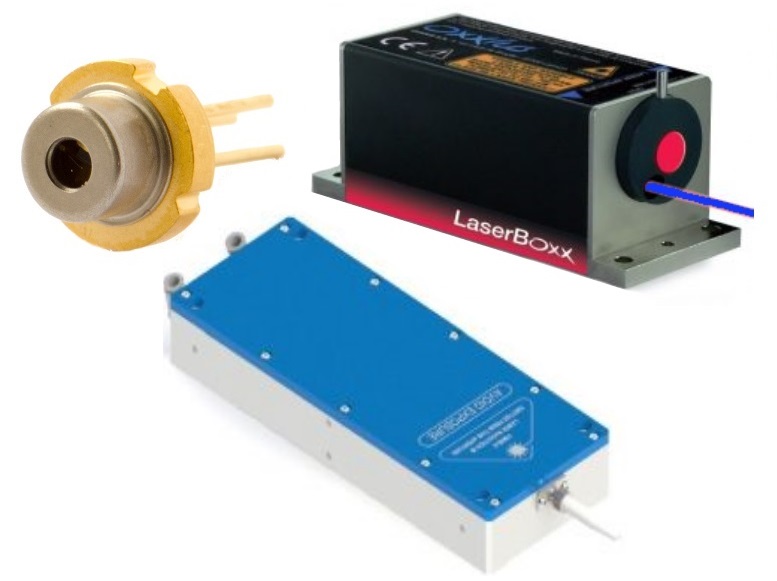
RPMC Lasers
RPMC Lasers offers a wide range of blue diode and DPSS lasers between 420 nm and 499 nm. These offerings include pulsed and CW lasers and modules with packaging at all levels of integration from TO can through turnkey system.
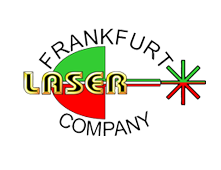

Frankfurt Laser Company
Frankfurt Laser Company offers indigo and blue laser diodes with emission wavelengths from 420 nm to 500 nm.

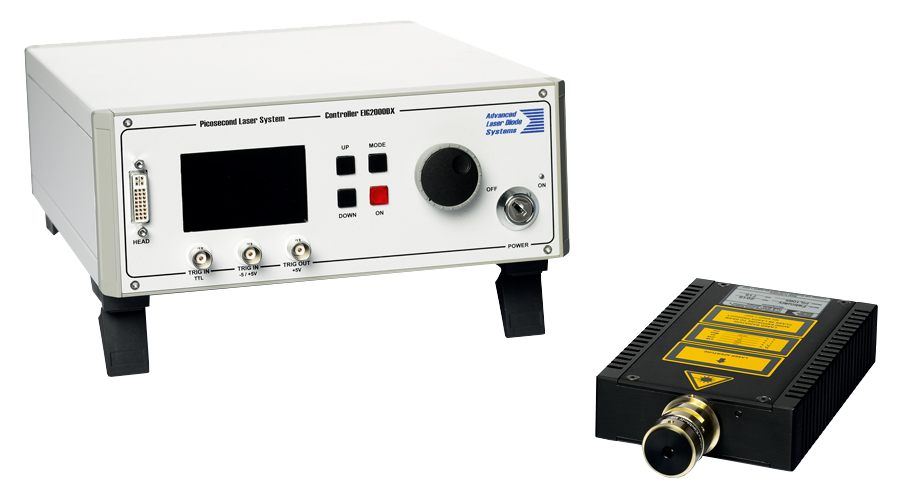
NKT Photonics
As part of our PILAS range of gain-switched pulsed diode lasers, we offer several blue lasers: The PiL040 with a wavelength of 405 nm, the Pil044 with a wavelength of 440 nm, and the PiL048 with a wavelength of 480 nm. All PILAS lasers offer triggable pulses down to 20 ps in a small footprint for both scientific and OEM applications. Available with output wavelengths from 375 nm to 1.6 μm, the PILAS lasers are very versatile and comes with low timing jitter, maintenance-free operation, and low cost of ownership.

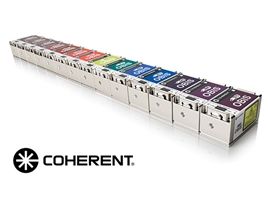
Edmund Optics
Edmund Optics offers blue lasers in the form of solid-state lasers from the Coherent OBIS™ series. Also, we provide violet and blue focusable laser diode modules.
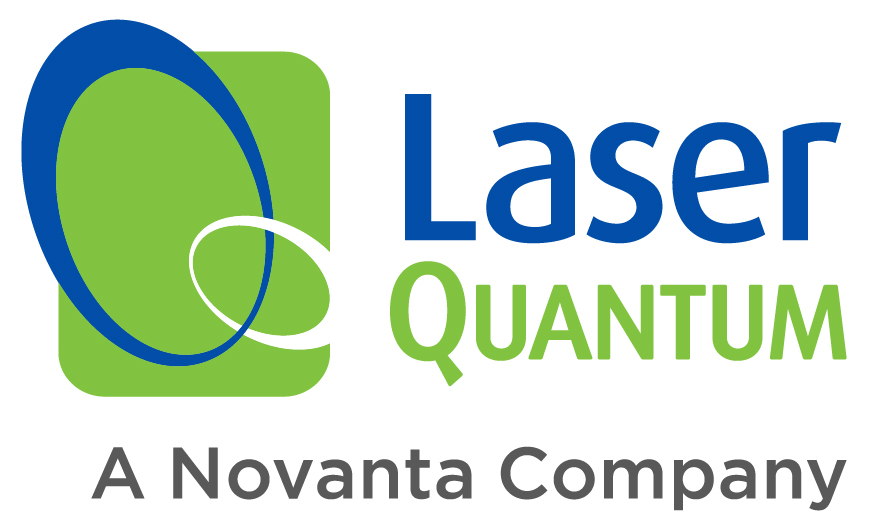

Laser Quantum
Laser quantum provides 473 nm blue lasers for both OEMs and scientific research, with powers of up to 500 mW. Ideal for fluorescence imaging, biomedical imaging, Raman spectroscopy and microscopy, lithography, optogenetics etc.


TOPTICA Photonics
TOPTICA supplies a wide range of high-quality lasers in the blue wavelength region. These include single-mode diode lasers (up to 300 mW), stabilized single-frequency diode lasers, tunable diode lasers as well as frequency-converted laser systems (up to 1 W).
Questions and Comments from Users
Here you can submit questions and comments. As far as they get accepted by the author, they will appear above this paragraph together with the author’s answer. The author will decide on acceptance based on certain criteria. Essentially, the issue must be of sufficiently broad interest.
Please do not enter personal data here; we would otherwise delete it soon. (See also our privacy declaration.) If you wish to receive personal feedback or consultancy from the author, please contact him e.g. via e-mail.
By submitting the information, you give your consent to the potential publication of your inputs on our website according to our rules. (If you later retract your consent, we will delete those inputs.) As your inputs are first reviewed by the author, they may be published with some delay.
Bibliography
| [1] | R. W. Wallace and S. E. Harris, “Oscillation and doubling of the 0.946-μm line in Nd3+:YAG”, Appl. Phys. Lett. 15, 111 (1969), doi:10.1063/1.1652925 |
| [2] | T. Hebert et al., “Blue and green CW upconversion lasing in Er:YLiF4”, Appl. Phys. Lett. 57, 1727 (1990), doi:10.1063/1.104048 |
| [3] | T. Hebert et al., “Blue continuous-pumped upconversion lasing in Tm:YLF”, Appl. Phys. Lett. 60, 2592 (1992), doi:10.1063/1.106919 |
| [4] | S. Nakamura et al., “InGaN-based multi-quantum-well-structure laser diodes”, Jpn. J. Appl. Phys. 35, L74 (1996) |
| [5] | D. G. Mathews et al., “Blue microchip laser fabricated from Nd:YAG and KNbO3”, Opt. Lett. 21 (3), 198 (1996), doi:10.1364/OL.21.000198 |
| [6] | R. Paschotta et al., “230 mW of blue light from a Tm-doped upconversion fibre laser”, JSTQE 3 (4), 1100 (1997), doi:10.1109/2944.649548 |
| [7] | M. Ghotbi et al., “High-average-power femtosecond pulse generation in the blue using BiB3O6”, Opt. Lett. 29 (21), 2530 (2004), doi:10.1364/OL.29.002530 |
| [8] | Z. Sun et al., “Generation of 4.3-W coherent blue light by frequency-tripling of a side-pumped Nd:YAG laser in LBO crystals”, “Opt. Express 12 (26), 6428 (2004)”, doi:10.1364/OPEX.12.006428 |
| [9] | M. Ghotbi and M. Ebrahim-Zadeh, “990 mW average power, 52% efficient, high-repetition-rate picosecond-pulse generation in the blue with BiB3O6”, Opt. Lett. 30 (24), 3395 (2005), doi:10.1364/OL.30.003395 |
| [10] | Q. H. Xue et al., “High-power efficient diode-pumped Nd:YVO4/LiB3O5 457 nm blue laser with 4.6 W of output power”, Opt. Lett. 31 (8), 1070 (2006), doi:10.1364/OL.31.001070 |
| [11] | T.-C. Lu et al., “CW lasing of current injection blue GaN-based vertical cavity surface emitting laser”, Appl. Phys. Lett. 92, 141102 (2008) |
| [12] | Z. Quan et al., “13.2 W laser-diode-pumped Nd:YVO4/LBO blue laser at 457 nm”, J. Opt. Soc. Am. B 26 (6), 1238 (2009), doi:10.1364/JOSAB.26.001238 |
| [13] | I. Akasaki, “Nobel Lecture: Fascinated journeys into blue light”, Rev. Mod. Phys. 87, 1119 (2015) |
| [14] | H. Amano, “Nobel Lecture: Growth of GaN on sapphire via low-temperature deposited buffer layer and realization of p-type GaN by Mg doping followed by low-energy electron beam irradiation”, Rev. Mod. Phys. 87, 1133 (2015) |
| [15] | S. Nakamura, “Nobel Lecture: Background story of the invention of efficient blue InGaN light emitting diodes”, Rev. Mod. Phys. 87, 1139 (2015) |
See also: lasers, green lasers, red lasers, laser diodes, frequency doubling, ultraviolet lasers
and other articles in the category lasers
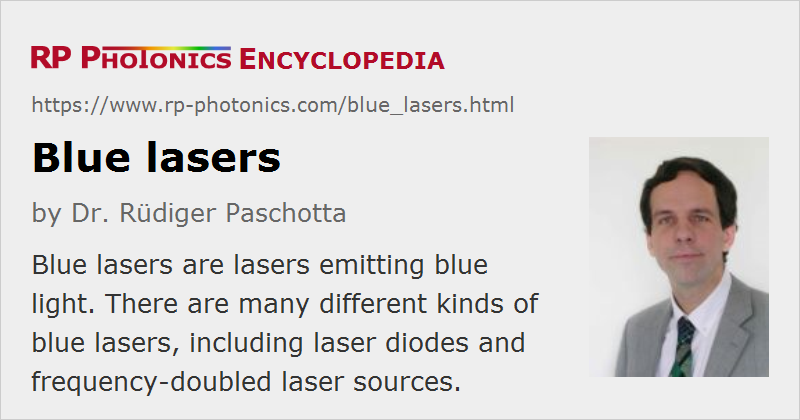 |



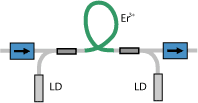

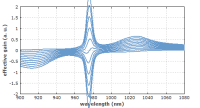
If you like this page, please share the link with your friends and colleagues, e.g. via social media:
These sharing buttons are implemented in a privacy-friendly way!